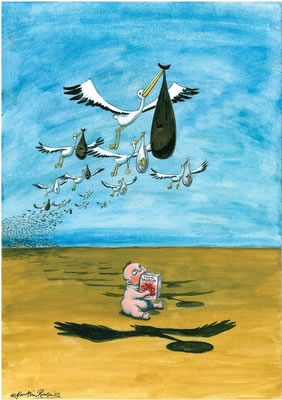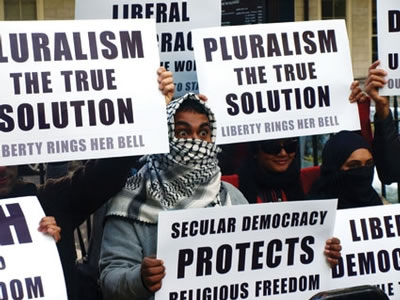Whenever demography is the subject a panicky headline usually follows. Generally these take the form of anxieties about overpopulation. “Are there just too many people in the world?” asks Johann Hari in the Independent. “The World’s population is still exploding,” confirms the Optimum Population Trust (patron David Attenborough). Though equally they could be about the opposite. “Is Europe Dying?” queries Catholic apologist George Weigel (before answering his own question: “The brute fact is that Europe is depopulating itself”). “Falling birth rate is killing Europe says Chief Rabbi Jonathan Sacks” is the Guardian’s offering. To these hysterical headlines let’s add another, especially for you secular folk: with birth rates of seven babies per women fundamentalists will take over the world. And here is the kicker: it’s all secularism’s fault.
 This grim prognostication comes courtesy of political scientist Eric Kaufmann, a reader in politics at London’s Birkbeck College, and the author of the new book Shall the Religious Inherit the Earth?, out in March from Profile Books. If, like me, you skip the six dense chapters of politico-demographic analysis, in the very last line of the book you can find his answer: “The religious shall inherit the earth.” There is, of course, an “unless” and we’ll get to that later, but let’s just let the idea sink in first.
This grim prognostication comes courtesy of political scientist Eric Kaufmann, a reader in politics at London’s Birkbeck College, and the author of the new book Shall the Religious Inherit the Earth?, out in March from Profile Books. If, like me, you skip the six dense chapters of politico-demographic analysis, in the very last line of the book you can find his answer: “The religious shall inherit the earth.” There is, of course, an “unless” and we’ll get to that later, but let’s just let the idea sink in first.
What Kaufmann is arguing is that the secularisation thesis, the assumption that modernity leads inexorably to a lessening of religious belief and a day when we are all rational humanists, is wrong – at one point Kaufmann approvingly quotes Rodney Stark and Roger Finke’s view that this is “a failed prophecy”. Further he is saying that there is something about our current form of liberal secularism that contains (here’s another headline) the seeds of its own destruction. Since the birth rate of individualistic secular people the world over is way below replacement level (2.1 in the West), and the birth rate of religious fundamentalists is way above (between 5 and 7.5 depending on sect), then through the sheer force of demography religious fundamentalism is going to become a much bigger force in the world and gain considerable political muscle. Literalist religious conservatism is being reborn and we secular liberals are the midwives.
So there’s the challenge. I met up with Kaufmann to see how well his case stands up. He arrives looking fresh and unrumpled after the 15-yard walk from his Bloomsbury office to ours. A surprisingly boyish Canadian, who has lived long enough in London to have acquired a wife and two kids of his own (just below the replacement rate, I couldn’t help noting), this is his third book – his first focused on American voting patterns and his second on Orangism in Northern Ireland. Kaufmann is not a demographer by trade but a political scientist specialising in ethnic conflict. He was drawn into the science of population flows because researching those books brought home the way in which ethnic and religious conflicts with political consequences are being reconfigured (the textbooks call this “religious restructuring”). The traditional rift between different religious sects is closing, while that between religious people of all denominations on the one hand and (what he calls rather inelegantly) the “seculars” on the other is widening. Embedded within these new trends was the unremarked but increasingly pivotal role played by differential fertility. This is the subject of the new book.
Behind the shouty headlines, Shall the Religious Inherit the Earth? is a detailed and patiently argued study, with convincing demographic data woven together with deft political analysis in three core case studies – of Israel, the US and Europe. But before delving into the detail I wanted to start with the central thesis. What is it about secularism, I wondered, that contains the seeds of its own destruction? “Well, I should make clear that I’m talking about our very specific kind of contemporary secularism,” he says. “By this I mean post-’60s secularism, one that is post-ideological, multicultural and liberal. My argument is that there is something about this multicultural liberal secularism that is good for fundamentalism and bad for itself.”
 OK, how? “I think in three ways. Firstly secular liberalism is individualistic, and therefore it goes hand in hand with delayed child bearing and lower fertility rates. Now you might say this is very good for the planet, but if you compare these rates with those who self-consciously maintain or increase their fertility rates you can see that this leads to population change. Second there is what you might call multicultural toleration of religious fundamentalism. Compare today with what happened when the Mormons tried to establish a theocracy in Utah in 1857. The US government would not allow it, and went to war with the Mormons to prevent it. You can’t imagine the government taking up arms against a religious sect today. The environment of toleration that characterises the West today gives religious fundamentalism breathing room and a degree of protection.” And third? “We are in a post-ideological phase. In place of the big political ideas, the quasi-religious ideologies like Communism, we have the issue of which party manages the economy better. The draining away of liberal ideology creates a vacuum that fundamentalism can exploit. These three things put secularism, in my view, at a disadvantage.”
OK, how? “I think in three ways. Firstly secular liberalism is individualistic, and therefore it goes hand in hand with delayed child bearing and lower fertility rates. Now you might say this is very good for the planet, but if you compare these rates with those who self-consciously maintain or increase their fertility rates you can see that this leads to population change. Second there is what you might call multicultural toleration of religious fundamentalism. Compare today with what happened when the Mormons tried to establish a theocracy in Utah in 1857. The US government would not allow it, and went to war with the Mormons to prevent it. You can’t imagine the government taking up arms against a religious sect today. The environment of toleration that characterises the West today gives religious fundamentalism breathing room and a degree of protection.” And third? “We are in a post-ideological phase. In place of the big political ideas, the quasi-religious ideologies like Communism, we have the issue of which party manages the economy better. The draining away of liberal ideology creates a vacuum that fundamentalism can exploit. These three things put secularism, in my view, at a disadvantage.”
But what kind of fundamentalism is he talking about? The book covers a wide array of sects from Haredis in Jerusalem to Hutterites in Montana and Salifis in Manchester. Some of the American and Jewish sects are hundreds of years old, but others – like Quiverfull and Salifism – are relatively new. What do they have in common?
“I call them ‘endogenous growth sects’. The defining features are that they have strong boundaries to the outside, they try to live segregated from the rest of society, they practice ‘in’ marriage, they have high fertility rates and high retention of members – it’s grow-your-own-fundamentalism. The irony is that in terms of growth this is the most successful model for religion in Western secular societies. This is not true for the developing world, or for the Muslim world, but it is for the West.” The reason why Kaufmann covers both older forms of fundamentalism like the Amish and Hutterites, sects that are not likely to put the fear of God into secularists because they seem so passive, so withdrawn and uninterested in imposing their worldview on the rest of us, alongside more aggressive and self-consciously power-hungry forms of evangelical Christianity and Islamism is because, in his argument, the older sects provide the model of success that is now being followed by the newer ones. To understand them, Kaufmann argues, we need to look at the older forms they are self-consciously aping.
Many of the arguments about the future are based on unique projections Kaufmann has made in collaboration with researchers at the World Population Program at Laxenburg in Austria, looking forward to 2050. But how reliable are the figures? “The data at IIASA is compiled from large social surveys done every two years in many countries,” he explains. “We take six years at a time to get a reliable data pool and correlate this with existing age structures for all the given groups, and of course fertility rates, to project ahead. It isn’t an exact science, but as far as social science is concerned it is pretty reliable.”
Turning to the data we should start with what Kaufmann describes as the “paradigm” case, that of Israel. What does Israel look like in 2050? “Simply put, a majority of the population in 2050 will be Haredi, that is Orthodox Jewish. From a trace element of the Israeli population in the 1950s, one out of three children in grade one are now Orthodox. They have achieved this with a fertility rate of 7.5 babies per woman, which has actually risen in the past decade.” Haredi have always had high fertility but this growth has been significantly helped by explicit government policy. Ultra-Orthodox communities have been subsidised so the men don’t have to work – they devote themselves to study and are relieved from service in the army. This of course has huge consequences for the politics of the region: “Traditionally the Haredi were relatively agnostic in regards to the peace process. They were anti-Zionist because they felt it was wrong to try and establish the state of Israel before time – they would play the hawks and doves off against each other. But now, since many live in settlements that are in occupied or disputed territory, they are becoming increasingly hawkish. And of course they have their own parties and they are politically active.” So demographics are bringing this traditionalist, paternalistic, inward-looking and reactionary belief system to the centre of Middle East politics.
 If Israel is the paradigm, and an example of the direct way in which birth rate can lead not only to the numerical growth of a sect but the expansion of their political power, the US provides a more diverse picture. Partly because, as Kaufmann is at pains to point at, birth rate matters much less when you are talking about a big country. The political issue is your share of the total population.
If Israel is the paradigm, and an example of the direct way in which birth rate can lead not only to the numerical growth of a sect but the expansion of their political power, the US provides a more diverse picture. Partly because, as Kaufmann is at pains to point at, birth rate matters much less when you are talking about a big country. The political issue is your share of the total population.
Strangely enough, Kaufmann has some cheering words to say about American secularism. While acknowledging that America is, and will remain, far more religious than Western Europe, the data shows that America is indeed becoming more secular (for the purposes of Kaufmann’s study it is not belief in God but affiliation to any particular religion which matters). Kaufmann cites statistics from the eminent American sociologist Robert Putnam, whose new book American Grace is all about American religiosity, that something like 35-40 per cent of young white Americans are secular. “America really is a case of delayed secularisation, what happened in Europe in the middle of the last century is happening to America now in terms of the young turning away from organised religion. Currently America is about 14 per cent secular, that is unaffiliated, and we predict this will grow to about 17 per cent by 2050, then plateau out.” This growth is not a matter of fertility rates. Secular fertility in America is as “stagnant” as everywhere else Kaufmann looks at, well below replacement at 1.65. But, Kaufmann admits, secularism profits from “conversion” – people born with religion become secular. However, these secular converts come overwhelmingly from moderate religions. Against what we might expect, the closed sects manage to cling on to their kids despite the temptations of mainstream society.
This is the heart of the American case. While secularism will grow, a bit, and moderate religions lose out a lot, it is fundamentalism that flourishes. There is a polarisation taking place where the outer reaches – irreligion and fundamentalism – grow and moderate religion is squeezed out. The consequences will be, in Kaufmann’s view, to increase the friction between the two groups.
In his American chapter Kaufmann goes to some lengths to describe the huge, and hugely unexpected, growth rates of sects we might have imagined would be obliterated by modernity. Thus the Hutterites, Anabaptist followers of 16th-century dissenter Jakob Hutter, who shun the modern world and live quiet communal lives in rural Middle America, have grown from a colony of 400 souls in 1900 to 50,000 today. Since they do not proselytise this is all internal growth. In the same period the buggy-driving Amish have grown from 5,000 to 250,000. That will double by 2050. For those born after 1945 there are more Mormons than Jews in the US population, and by 2050 Mormons will displace Jews as the third largest religious group in America (by which point American Muslims will push Jews into fifth). Kaufmann stresses that the situation is very different to that of the Haredi in Israel; these are still very small communities in terms of the overall population, and communities like the Amish and Hutterites are uninterested in politics or imposing their values on others, at least for now.
 However the success-through-fertility of these groups has served as a powerful model for newer variants of fundamentalism with a far more sinister agenda. One such is the Quiverfull movement (The name derives from Psalm 127: “Children are a heritage from the Lord/ Happy is the man who has his quiver full of them”). Kaufmann describes Quiverfull as “backward engineered religion”, an attempt to replicate the successful growth of these historic sects, combined with an ambitious agenda for political power. Under the leadership of the infamous religious conservative Doug Phillips, son of Howard, who was instrumental in the early stirrings of the Religious Right, Quiverfull, a coalition of neo-fundamentalist protestant denominations and communities, dedicated to biblical literalism, deeply patriarchal and morally conservative and separatist in mindset, has a 200-year plan, a “self-conscious strategy for victory through fertility”, as Kaufmann calls it. “They look around and see the low birth rate amongst the secular population, and the success of the sects, and they say, ‘Hey, we can take over here and quickly.’ They think that God should be the family planner. For them contraception is one step toward abortion. There are stories of Quiverfull women who can only have three or four children breaking down and feeling that God has not blessed them.”
However the success-through-fertility of these groups has served as a powerful model for newer variants of fundamentalism with a far more sinister agenda. One such is the Quiverfull movement (The name derives from Psalm 127: “Children are a heritage from the Lord/ Happy is the man who has his quiver full of them”). Kaufmann describes Quiverfull as “backward engineered religion”, an attempt to replicate the successful growth of these historic sects, combined with an ambitious agenda for political power. Under the leadership of the infamous religious conservative Doug Phillips, son of Howard, who was instrumental in the early stirrings of the Religious Right, Quiverfull, a coalition of neo-fundamentalist protestant denominations and communities, dedicated to biblical literalism, deeply patriarchal and morally conservative and separatist in mindset, has a 200-year plan, a “self-conscious strategy for victory through fertility”, as Kaufmann calls it. “They look around and see the low birth rate amongst the secular population, and the success of the sects, and they say, ‘Hey, we can take over here and quickly.’ They think that God should be the family planner. For them contraception is one step toward abortion. There are stories of Quiverfull women who can only have three or four children breaking down and feeling that God has not blessed them.”
Throughout his book, and our conversation, Kaufmann has been careful to suppress any moral judgements about the rise of fundamentalisms like Quiverfull – he even expresses a certain admiration for those with strongly held beliefs – but can’t he see that for many of us the emergence and strengthening of patriarchal religious cultism like this looks terrifying? Just imagine what it might be like for a girl born to Quiverfull parents who was unable to bear children, or was, God forbid, a lesbian.
“Yes,” he agrees, “it’s a nightmare.”
For Kaufmann it is too early to tell what impact these new variants of ultra-modern fundamentalism will have, how successful their gyno-political strategy will be, but already he can see signs that the ultra-religious are collaborating on specific issues. “Conservative Catholics and Protestants have combined on single issues, like the passing of Proposition 8, the anti-gay marriage legislation, in California and we are going to see much more of that.” In this coalition of the pious, American Muslims are set to play a much bigger role too. While American variants of Islam largely shun Islamism because of its anti-Americanism – with a few high profile exceptions – the growing size of the American Muslim population, in Kaufmann’s view, will mean that they vote with other religious conservatives on moral value issues.
And finally to Europe, or “Eurabia” as it is known in the more hysterical screeds of right-wing propagandists like Melanie Phillips, Mark Steyn and Geert Wilders. Do his projections regarding Europe’s population change confirm or contradict the dire warnings that (white, Christian) Europe is dying and being replaced with Muslims?
 “Well, “ he says, “a little of both. What I’m arguing about Europe is different to what I’m arguing about Israel. In Europe the impact is less direct. In some minor cases fundamentalist sects are growing – like the Orthodox Calvinists in Holland – but immigration is a much bigger issue here. Immigrants have a much higher fertility rate and are also religious, but they are not all fundamentalists. Most immigrants are traditional and moderate. But this then collides with the secular culture, and out of that you can get fundamentalism of a modern variety, explicitly pitched against secularism. What even theorists of secularisation will admit is that religion can flourish when it takes on an ethnic role, for example in Poland Catholicism became symbolic of resistance to the Russians. Something similar is happening here. Immigrants come in, they are ethnically different and religion comes to symbolise the ethnic identity, especially so if they feel embattled. This insulates religion from secularism. Rather than becoming more moderate immigrants and their children become more religious. This is not to say that all Muslims will become fundamentalists, but it does allow the religion to grow. The next question is, does contact with secularism lead to the growth of extremism, and there is some evidence for this.
“Well, “ he says, “a little of both. What I’m arguing about Europe is different to what I’m arguing about Israel. In Europe the impact is less direct. In some minor cases fundamentalist sects are growing – like the Orthodox Calvinists in Holland – but immigration is a much bigger issue here. Immigrants have a much higher fertility rate and are also religious, but they are not all fundamentalists. Most immigrants are traditional and moderate. But this then collides with the secular culture, and out of that you can get fundamentalism of a modern variety, explicitly pitched against secularism. What even theorists of secularisation will admit is that religion can flourish when it takes on an ethnic role, for example in Poland Catholicism became symbolic of resistance to the Russians. Something similar is happening here. Immigrants come in, they are ethnically different and religion comes to symbolise the ethnic identity, especially so if they feel embattled. This insulates religion from secularism. Rather than becoming more moderate immigrants and their children become more religious. This is not to say that all Muslims will become fundamentalists, but it does allow the religion to grow. The next question is, does contact with secularism lead to the growth of extremism, and there is some evidence for this.
“In our projections for Western Europe by 2050 we are looking at a range of 10-15 per cent Muslim population for most of the high immigration countries – Germany, France, the UK. So there will be an increase but it is not what the Eurabia critics say. Their projections are completely off base. Muslims will not be a majority in Europe, but a significant minority. Here, as in the US, the issue is not of the takeover by one or other fundamentalist sect, but of the possibility, I might even say likelihood, of ultra-Conservative sects, both Muslim and Christian, making common cause and political alliance. They are already showing that they can successfully piggyback on the inter-faith agenda to acquire a political voice.”
It’s a stark picture, but is he right? It is hard for a non-specialist to argue with the demographic data, although the fact that he hedges quite a bit on the outcomes suggests there is some room for interpretation. Not, perhaps, about Israel, but certainly about what role fundamentalism will play in Europe. I ask him what he thinks we should be doing about it. Should we, for example, all be shagging for secularism?
“Well, I don’t think we want to get in a population footrace. It may be necessary for secular people to have slightly more children but it would be nicer if we could get fundamentalists to have fewer children.” A strangely authoritarian notion to fall from the lips of a self-confessed liberal. “Yes,” he admits, “imposing restrictions would be condemned as discriminatory. But there are carrots as well as sticks. In Israel there is a push to withdraw subsidies to the Haredi, and to insist that they serve in the army. But I’m not convinced that that will do a lot.”
Another scenario he imagines in his conclusion is that secularism might start to do a better job of winning over the children of religious fundamentalism. But at the moment he sees no statistical sign of this, and he seems gloomy about the prospect. Why? “Part of my argument is that religion does provide that enchantment, that meaning and emotion, and in our current moment we lack that. This is the challenge for secularism: can it come up with such an ideology?”
To my mind this looks a worrying prospect. Counter religion by producing a new kind of secular enchantment? Doesn’t it also betray a lack of conviction about the values that underpin our current society and the appeal they might hold for anyone who comes into contact with them? In a review of Christopher Caldwell’s book on European migration, which made similar warnings to Kaufmann’s, Kenan Malik undercuts the scaremongering that so often accompanies discussion of demography by suggesting that we already have a powerful weapon against the trends, if only we could see it. “What has eroded,” he argues, “is faith in the idea that it is possible to win peoples of different backgrounds to a common set of secular, humanist, enlightened values. And that is the real problem: not immigration, nor Muslim immigration, but the lack of conviction in a progressive, secular, humanist project.”
What Kaufmann and Malik are certainly in accord on is the need to displace the multicultural “celebration of difference” model of toleration with one that contains a far more robust sense of common values and a far more stringent rejection of reactionary fundamentalism. “We need a stronger sense of liberal values,” Kaufmann told me. “We should answer back to all fundamentalisms.”
 To achieve this he argues, in a way that will make Tony Blair’s heart leap, that secularists might need to collaborate more with religious moderates – find common cause in the way fundamentalists are doing. “The issue is not belief in God, but organised religion, especially fundamentalism. Non-believers can still have a rich conversation with moderate people who believe in God. You can’t have a conversation with a fundamentalist.”
To achieve this he argues, in a way that will make Tony Blair’s heart leap, that secularists might need to collaborate more with religious moderates – find common cause in the way fundamentalists are doing. “The issue is not belief in God, but organised religion, especially fundamentalism. Non-believers can still have a rich conversation with moderate people who believe in God. You can’t have a conversation with a fundamentalist.”
If Kaufmann admits that his scary headlines somewhat belie the provisional nature of his findings, he has an answer: “I am trying to force a certain rethink of the idea that we are moving naturally toward secularism. To shake up our complacency and, perhaps, stir up some debate.”
Secularists may well be shaken by his book, but will they be stirred?
Letters to the editor: send us your thoughts for our letter pages by email to editor@newhumanist.org.uk

